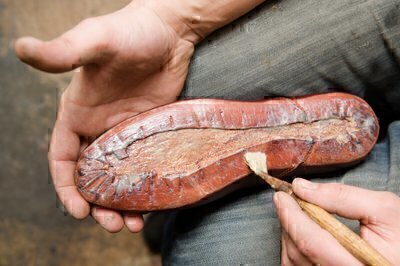What Can Shoe Repair Shops Do?
Last updated April 2020
 Heels and Lifts
Heels and Lifts
Worn-down heels not only look awful, they may cause strains and pains in your ankles, legs, and back. And, if you’ve really let those old loafers go, you might even see tiny cobblers’ nail tips emerge, which will irritate your feet (and might cause injuries).
Shoe repair pros use replacement heels made of rubber, leather, or a combination of both materials. To keep your shoes looking good, we recommend leather or combo heels. But rubber ones are softer and quieter to walk on, and rubber replacement heels cost around $3 to $8 less.
The piece on the bottom of the heel of high-heeled shoes is called a lift. Because its area of impact is so small, it usually wears out pretty quickly. Replacement lifts are either glued on or glued and nailed. To extend the life of any heel, have plastic taps—usually just a couple of bucks—put on the back.
Soles
Soles need to be replaced when holes appear, the old soles soften at the points of greatest wear, or you begin to feel the ground.
You can get either full replacement soles or half soles. Full soles cost more (typically $10 to $14 extra) and require that the heel be replaced, even if it has not yet worn down. Half soles are cheaper and almost always used on high heels. The main reason some people prefer full soles is appearance.
When resoling shoes, you can choose between synthetic and leather. In general, if you’re paying to resole expensive shoes, you’ll probably want to pay a little more for leather since it’s more flexible and porous, which allows your tootsies to breathe and not get too sweaty or hot. But synthetics are waterproof, which can be a plus.
To be sure your shop is good at redoing soles, check that it shapes shoes on a form or last; replaces any damaged fillers in between the inner and outer soles; and that it removes old stitches from the welt—the narrow strip of leather around the top edge of the sole of many men’s shoes. If old stitches aren’t taken out, it’ll both look bad and cause the repair needle to punch new or larger holes and weaken the welt. Finally, the shop should shape and glue half soles so that no crack appears where the new piece meets the old.
Stretching and Other Comfort Improvements
Shoe repair shops often can make shoes fit a bit better. They can stretch a pair that’s a little too tight, add some space for toes, or raise an instep. They can also make footwear comfier and wear better with a range of tricks and add ons, including heel cushions and insoles. The key is telling the pro where your shoe is rubbing, where it isn’t fitting, and what your problem is—a good sole doc can suggest solutions.
Other Repairs
Other jobs performed by shoe repair shops include dyeing, patching cuts in uppers, cutting out toe holes, replacing straps, re-securing uppers to soles, adjusting fit, waterproofing, and making orthopedic shoes. Some shops also do non-shoe work, such as repairing luggage, baseball mitts, leather garments, belts, and bags.


